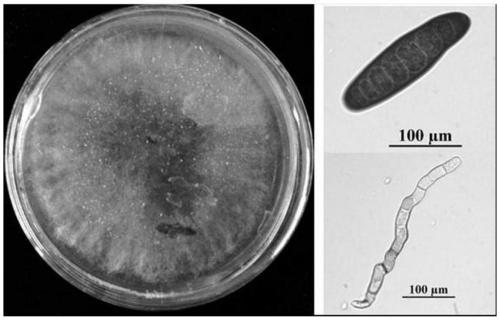Method for high throughput screening of microorganisms for preventing plant soil-borne fungal diseases
A technology of soil-borne fungi and microorganisms, which is applied in the field of agricultural microorganisms, can solve the problems of indeterminate microbial reproduction, difficulty in large-scale operation, and inconformity with production conditions, so as to save cultivation materials and operating space, shorten the screening cycle, and occupy space small effect
- Summary
- Abstract
- Description
- Claims
- Application Information
AI Technical Summary
Problems solved by technology
Method used
Image
Examples
Embodiment 1
[0033] Embodiment 1: the cultivation of wheat root rot bacteria
[0034] The Umbilophilus tritici used in the present invention was purchased from the China Agricultural Microorganism Culture Collection and Management Center, and the strain number is ACCC 36529. This strain can grow on PDA medium. Under the environment of 25~30℃, the hyphae can cover the whole surface of the medium within 2-3 days, and then begin to grow aerial hyphae, and produce brown or brown branches in 4-6 days. Sporulation. Conidia are oblong or fusiform, with 3-9 septa. Umbilical point broad, base truncated ( figure 1 ).
Embodiment 2
[0035] Embodiment 2: the preparation of wheat root rot fungus diseased soil
[0036]Preparation of culture medium: Soak the wheat seeds overnight, filter the water the next day, put the wheat seeds that have absorbed enough water into the triangular flask, the amount of seeds in each bottle (by volume, v / v) 30-40%, intermittently Sterilize twice.
[0037] Cultivation of diseased soil: Cut the spore-forming Helminthospora tritici together with the culture medium into small pieces, inoculate them into a triangular flask containing sterilized wheat, mix well, and culture in the dark at 28°C for 5~ 8 days until the mycelium of the pathogenic fungus is covered with wheat seeds; light culture at 28°C for 2 weeks, until Helminthosporium tritici produces black spores on the wheat seeds; dry with natural ventilation for 1-2 days, and use a pulverizer to slightly pulverize it to obtain Containing the diseased soil of umbilical sp. tritici, the concentration of umbilical sp. spores in t...
Embodiment 3
[0038] Embodiment 3: Determination of the use ratio of wheat root rot fungus diseased soil
[0039] In the soil with nutrient soil and sandy soil = 1:1, the diseased soil containing wheat root rot bacteria produced in Example 2 was added according to different volume ratios, and the growth of wheat was observed. When the wheat seedlings show slow emergence, short growth, and lesions on the leaves, it is considered as a symptom of the disease. Select the ratio of symptoms appearing under the minimum addition amount to repeat. The results showed that when the addition ratio of wheat root rot fungus diseased soil was greater than 10% (v / v), compared with the blank control, the emergence rate was seriously delayed or no emergence, the growth was seriously damaged or basically could not grow; When the addition ratio of rot fungus soil is 2.5% (v / v), compared with the blank control, there is no obvious phenomenon of slow growth and short plant; when the addition volume is 5% to 10%...
PUM
 Login to View More
Login to View More Abstract
Description
Claims
Application Information
 Login to View More
Login to View More - R&D
- Intellectual Property
- Life Sciences
- Materials
- Tech Scout
- Unparalleled Data Quality
- Higher Quality Content
- 60% Fewer Hallucinations
Browse by: Latest US Patents, China's latest patents, Technical Efficacy Thesaurus, Application Domain, Technology Topic, Popular Technical Reports.
© 2025 PatSnap. All rights reserved.Legal|Privacy policy|Modern Slavery Act Transparency Statement|Sitemap|About US| Contact US: help@patsnap.com



